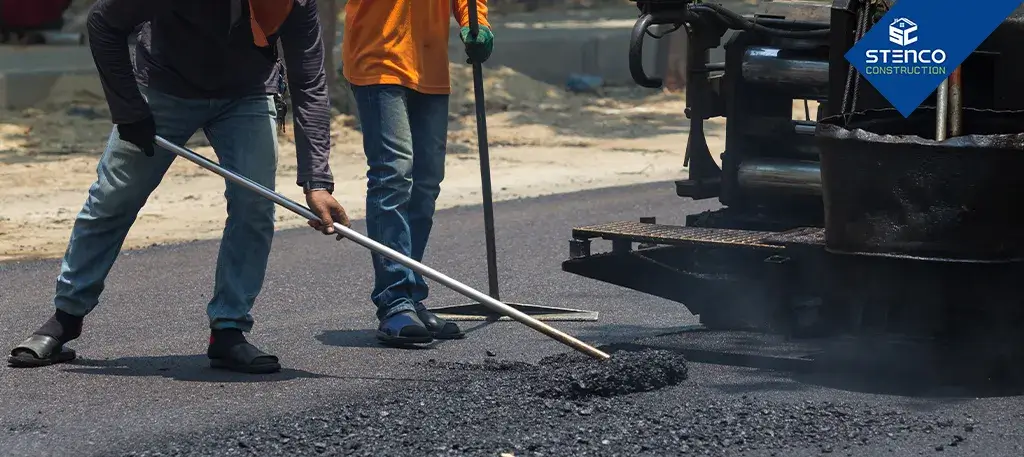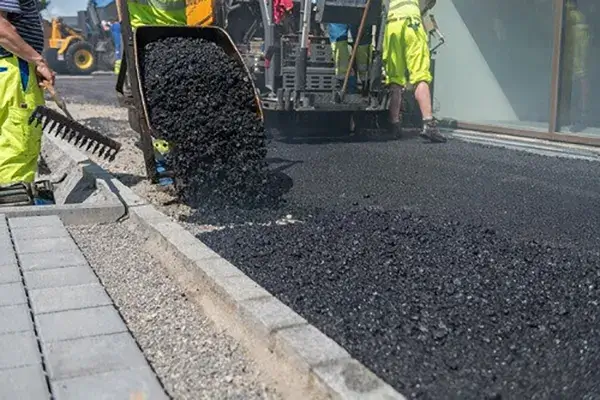CALL US FREE ESTIMATE
CALL US FREE ESTIMATE

Asphalt pavement is commonly used for roadways, parking lots, and other similar surfaces. Proper installation of asphalt pavement is essential to ensure its durability and longevity. In this process, several steps are involved, from planning and preparation to finishing and curing. Each step requires careful attention to detail and skilled execution to ensure a smooth and stable surface. Here we will discuss its process in detail.
Planning and preparation are crucial steps in the process of asphalt pavement installation. It involves a detailed evaluation and assessment of the site, selecting materials and equipment, and determining the resources needed to complete the project. A thorough site evaluation is essential to identify potential issues or challenges during installation. This includes assessing the soil quality, checking for drainage issues, and evaluating the existing pavement or surface. The appropriate materials and equipment required for the project are selected based on the evaluation. This includes determining the type and amount of asphalt mix, the thickness of the pavement, and the equipment needed for excavation, grading, and compaction. Proper planning and preparation ensure that the project is completed efficiently and effectively, reducing the likelihood of delays, mistakes, or unexpected costs.
Site preparation is a critical step in the process of asphalt pavement installation. It involves several tasks to ensure the site is properly cleared, graded, and leveled before the asphalt pavement is installed. The first task in site preparation is clearing the area of any debris, including rocks or other materials that may interfere with the installation process. Once the site is cleared, the surface must be graded to ensure it is level and has the proper slope for drainage. Proper drainage is critical to prevent water from pooling on the surface, which can lead to damage or the premature wear of the pavement. Next, the site is compacted to provide a stable base for the asphalt pavement. Finally, adjustments are made to ensure the surface is properly graded and leveled before the asphalt pavement is installed. Proper site preparation ensures the asphalt pavement has a solid foundation, reducing cracks, potholes, or other damage over time.

The base layer is a critical component of the asphalt pavement, providing support and stability to the surface. The base layer is typically composed of crushed stone, gravel, or other aggregates, compacted to create a strong and stable foundation. The thickness of the base layer varies depending on the specific project requirements and the condition of the underlying surface. A thicker base layer may be required for surfaces with poor soil quality or heavy traffic loads. The installation process for the base layer involves several steps, starting with placing the aggregate material onto the prepared surface. The material is then spread evenly and compacted using heavy equipment, such as rollers or compactors, to achieve the desired density. Proper installation of the base layer is essential to prevent settlement, cracking, or other damage to the asphalt pavement over time.
The next in the process of asphalt pavement installation is the binder layer. It is applied over the base layer. The binder layer is composed of a mixture of asphalt and aggregate materials, which provide additional strength and durability to the pavement. The thickness of the binder layer varies depending on the specific project requirements and the expected traffic loads. The installation process for the binder layer is similar to that of the base layer, starting with placing the asphalt mix onto the prepared surface. The mixture is spread evenly and compacted using heavy equipment to achieve the desired density. The binder layer also helps to prevent water infiltration, reducing the likelihood of damage or deterioration due to moisture. Proper installation of the binder layer is essential to ensure the longevity and durability of the asphalt pavement.

Surface layer is the final layer in the process of asphalt pavement installation, applied over the binder layer. The pavement's most visible and functional surface layer provides a smooth, durable driving surface. The surface layer typically comprises a high-quality asphalt mix to withstand heavy traffic loads, weathering, and other environmental factors. The thickness of the surface layer varies depending on the specific project requirements and the expected traffic loads. The installation process for the surface layer is similar to that of the binder layer, starting with placing the asphalt mix onto the prepared surface. The mixture is spread evenly and compacted using heavy equipment to achieve the desired density and smoothness. Proper installation of the surface layer is essential to ensure the safety and functionality of the asphalt pavement, reducing the likelihood of skidding, hydroplaning, or other safety hazards.

Finishing is the final step in asphalt pavement installation. Finishing involves several tasks to ensure the pavement is properly compacted, leveled, and free of surface imperfections. This includes using specialized equipment to smooth out any bumps or uneven areas and applying a final layer of asphalt mix to provide a smooth and uniform driving surface. Once the finishing process is complete, the pavement must be cured, allowing the asphalt to harden and bond to the underlying layers fully. This process typically involves covering the pavement with a layer of protective material, such as burlap or plastic, to prevent moisture from penetrating the surface. The pavement must be left to cure for a specific period of time, depending on the temperature and humidity conditions, before it can be opened to traffic. Proper finishing is essential to ensure the longevity and durability of the asphalt pavement, reducing the likelihood of cracks or other damage over time.
Asphalt pavement installation is a complex process involving several critical steps to ensure the pavement's durability, functionality, and safety. Proper planning and preparation, including site preparation and base layer installation, provide a stable foundation for the pavement. Each step in the process requires careful attention to detail and specialized equipment to achieve the desired results. Proper installation and maintenance of asphalt pavement can significantly extend its lifespan and reduce the likelihood of damage or deterioration over time.
If you are looking for asphalt pavement, then look no further and contact Stenco Constructions. Our professional asphalt contractors are committed to delivering high-quality, long-lasting pavement solutions to our clients. Contact us today to discuss your project requirements and schedule a consultation with our team.
No matter what type of project you have, we can help